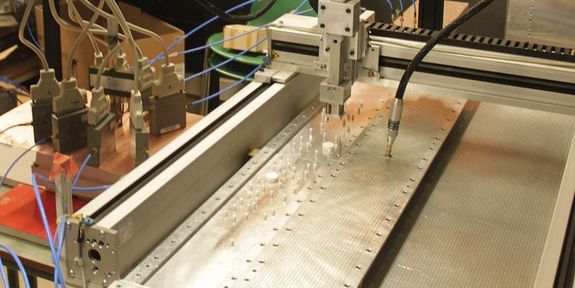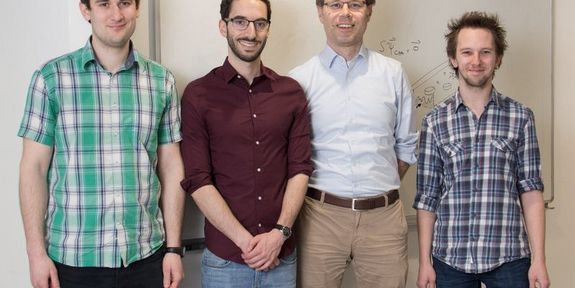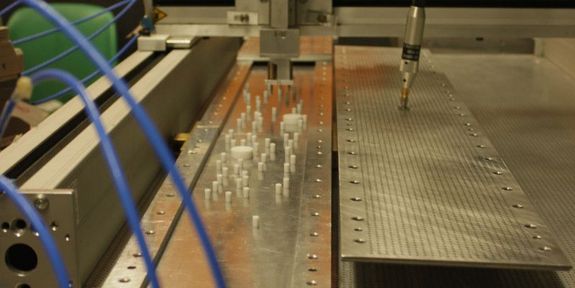The laser is the perfect light source: when being provided with energy, it generates light of a specific, well-defined colour. It is also possible, however, to create the exact opposite – an object that perfectly absorbs light of a particular colour and dissipates the energy almost completely.
At TU Wien (Vienna), a method has now been developed to make use of this effect, even in very complicated systems in which light waves are randomly scattered in all directions. The method was developed by the team in Vienna with the help of computer simulations, and confirmed by experiments in cooperation with the University of Nice. This opens up new possibilities for all areas in science and engineering where wave phenomena play an important role. The new method has now been published in the journal "Nature".
Random structures that absorb waves
"Waves that are being scattered in a complex way are really all around us - think about a mobile phone signal that is reflected several times before it reaches your cell phone," says Prof. Stefan Rotter from the Institute for Theoretical Physics of TU Wien. "This multiple scattering is made practical use of in so-called random lasers. Such exotic lasers are based on a disordered medium with a random internal structure that can trap light and emit a very complicated, system-specific laser field when supplied with energy."
With mathematical calculations and computer simulations, Rotter's team could show that this process can also be reversed in time. Instead of a light source that emits a specific wave depending on its random inner structure, it is also possible to build the perfect absorber, which completely dissipates an incoming wave with the right colour and spatial pattern in accordance with its characteristic internal structure. The easiest way to think about this process is in terms of a movie showing a conventional laser sending out laser light, which is played backwards.
"Because of this time-reversal analogy to a laser, such absorbers are called anti-lasers," says Stefan Rotter. "So far, anti-lasers have only been realized in one-dimensional structures onto which laser light was directed from opposite sides. Our approach is much more general: we were able to show that even arbitrarily complicated structures in two or three dimensions can perfectly absorb a suitably tailored wave. In this way, this novel concept can also be used for a much wider range of applications."
The perfect wave absorber
The main result of the research project: For every object that absorbs waves sufficiently strongly, a certain wave front can be found, which is perfectly absorbed by this object. "It would be wrong to imagine, however, that this is all about the absorber just being strong enough to swallow every incoming wave," says Stefan Rotter. "Instead, the effect is due to a complex scattering process in which the incident wave splits into many partial waves, which then overlap and interfere with each other in such a way that none of these partial waves can get out at the end." In this sense also the absorber used in the anti-laser can be rather weak - for example a simple antenna that absorbs electromagnetic waves can already do the trick.
To test their calculations, the team worked together with the University of Nice. Kevin Pichler, the first author of the Nature publication, who is currently working on his dissertation in the team of Stefan Rotter, spent several weeks with Prof. Ulrich Kuhl at the University of Nice to implement the theory in a microwave experiment. "I would say it is quite unusual for a theorist to also perform the experiment," says Kevin Pichler. "I found it very exciting though to be involved in all aspects of this project, from the theoretical concept to its implementation in the laboratory."
The "Random Anti-Laser" built in the laboratory consists of a microwave chamber with a central absorbing antenna, surrounded by a random arrangement of Teflon cylinders. Similar to stones in a puddle of water, at which water waves are deflected, these cylinders can scatter microwaves and create a complicated wave pattern. "First we send microwaves onto the system from the outside and measure how exactly they come back," explains Kevin Pichler. "This knowledge then allows us to characterize the random structure and to calculate the wave front that is completely swallowed by the central antenna at the right absorption strength. In fact, when implementing this protocol in the experiment, we find an absorption of approximately 99.8% of the incident signal."
While anti-laser technology is still in its early stage, it is easy to think of potential applications. "Imagine, for example, that you could adjust a cell phone signal exactly the right way, so that it is perfectly absorbed by the antenna in your cell phone," says Stefan Rotter. "Also in medicine, we often deal with the task of delivering wave energy to a very specific point - such as shock waves shattering a kidney stone."
Original publication:
Photo download, opens an external URL in a new window
Contact:
Prof. Stefan Rotter
Institute for Theoretical Physics
TU Wien
Wiedner Hauptstraße 8-10, 1040 Vienna
stefan.rotter@tuwien.ac.at
Dipl.-Ing. Kevin Pichler
Institute for Theoretical Physics
TU Wien
Wiedner Hauptstraße 8-10, 1040 Vienna
T: +43-1-58801-13644
kevin.pichler@tuwien.ac.at


